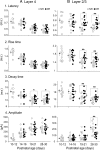Laminar-specific maturation of GABAergic transmission and susceptibility to visual deprivation are related to endocannabinoid sensitivity in mouse visual cortex
- PMID: 20962247
- PMCID: PMC6634750
- DOI: 10.1523/JNEUROSCI.2979-10.2010
Laminar-specific maturation of GABAergic transmission and susceptibility to visual deprivation are related to endocannabinoid sensitivity in mouse visual cortex
Abstract
The developmental period when neuronal responses are modified by visual experience is reported to start and end earlier in layer 4 than in layer 2/3 of the visual cortex, and the maturation of GABAergic inhibitory circuits is suggested to determine the timing of this period. Here, we examine whether the laminar difference in such timing corresponds to a difference in the time course of the functional maturation of GABAergic synaptic transmission to star pyramidal and pyramidal cells in layers 4 and 2/3, respectively, of the mouse visual cortex and whether the development of the strength of GABAergic transmission is affected by visual deprivation in a laminar-specific manner. Our analysis of developmental changes in inhibitory postsynaptic currents of star pyramidal and pyramidal cells evoked by electrical stimulation of afferents or action potentials of fast-spiking GABAergic neurons revealed that there was a sequential maturation of GABAergic function from layers 4 to 2/3. The maturation of inhibition in layer 4 occurred at postnatal week 3, which preceded by 1 week that of layer 2/3. Visual deprivation by dark rearing arrested the functional development of GABAergic transmission in layer 2/3, whereas dark rearing was not so effective in layer 4. GABAergic synapses in layer 2/3 were sensitive to an agonist for cannabinoid type 1 receptors and not normally matured in receptor knock-out mice, whereas those in layer 4 were not so. These results suggest laminar-specific maturation of inhibition and susceptibility to visual deprivation, which may be related to the laminar difference in sensitivity to endocannabinoids.
Figures









Similar articles
-
Layer-specific endocannabinoid-mediated long-term depression of GABAergic neurotransmission onto principal neurons in mouse visual cortex.Eur J Neurosci. 2015 Aug;42(3):1952-65. doi: 10.1111/ejn.12958. Epub 2015 Jun 15. Eur J Neurosci. 2015. PMID: 25997857
-
Dark rearing alters the development of GABAergic transmission in visual cortex.J Neurosci. 2002 Sep 15;22(18):8084-90. doi: 10.1523/JNEUROSCI.22-18-08084.2002. J Neurosci. 2002. PMID: 12223562 Free PMC article.
-
Differential effects of endocannabinoids on glutamatergic and GABAergic inputs to layer 5 pyramidal neurons.Cereb Cortex. 2007 Jan;17(1):163-74. doi: 10.1093/cercor/bhj133. Epub 2006 Feb 8. Cereb Cortex. 2007. PMID: 16467564
-
Maturation of GABAergic transmission and the timing of plasticity in visual cortex.Brain Res Brain Res Rev. 2005 Dec 1;50(1):126-33. doi: 10.1016/j.brainresrev.2005.05.007. Epub 2005 Jul 15. Brain Res Brain Res Rev. 2005. PMID: 16024085 Review.
-
Assortment of GABAergic plasticity in the cortical interneuron melting pot.Neural Plast. 2011;2011:976856. doi: 10.1155/2011/976856. Epub 2011 Jul 11. Neural Plast. 2011. PMID: 21785736 Free PMC article. Review.
Cited by
-
Long-term inhibitory plasticity in visual cortical layer 4 switches sign at the opening of the critical period.Proc Natl Acad Sci U S A. 2013 Nov 19;110(47):E4540-7. doi: 10.1073/pnas.1319571110. Epub 2013 Nov 4. Proc Natl Acad Sci U S A. 2013. PMID: 24191045 Free PMC article.
-
Neural cell adhesion molecule NrCAM regulates Semaphorin 3F-induced dendritic spine remodeling.J Neurosci. 2014 Aug 20;34(34):11274-87. doi: 10.1523/JNEUROSCI.1774-14.2014. J Neurosci. 2014. PMID: 25143608 Free PMC article.
-
Deprivation-induced strengthening of presynaptic and postsynaptic inhibitory transmission in layer 4 of visual cortex during the critical period.J Neurosci. 2014 Feb 12;34(7):2571-82. doi: 10.1523/JNEUROSCI.4600-13.2014. J Neurosci. 2014. PMID: 24523547 Free PMC article.
-
Vision loss shifts the balance of feedforward and intracortical circuits in opposite directions in mouse primary auditory and visual cortices.J Neurosci. 2015 Jun 10;35(23):8790-801. doi: 10.1523/JNEUROSCI.4975-14.2015. J Neurosci. 2015. PMID: 26063913 Free PMC article.
-
Adrenergic gating of Hebbian spike-timing-dependent plasticity in cortical interneurons.J Neurosci. 2013 Aug 7;33(32):13171-8. doi: 10.1523/JNEUROSCI.5741-12.2013. J Neurosci. 2013. PMID: 23926270 Free PMC article.
References
-
- Benevento LA, Bakkum BW, Cohen RS. Gamma-aminobutyric acid and somatostatin immunoreactivity in the visual cortex of normal and dark-reared rats. Brain Res. 1995;689:172–182. - PubMed
-
- Cynader M. Prolonged sensitivity to monocular deprivation in dark-reared cats: effects of age and visual exposure. Brain Res. 1983;284:155–164. - PubMed
Publication types
MeSH terms
Substances
LinkOut - more resources
Full Text Sources
